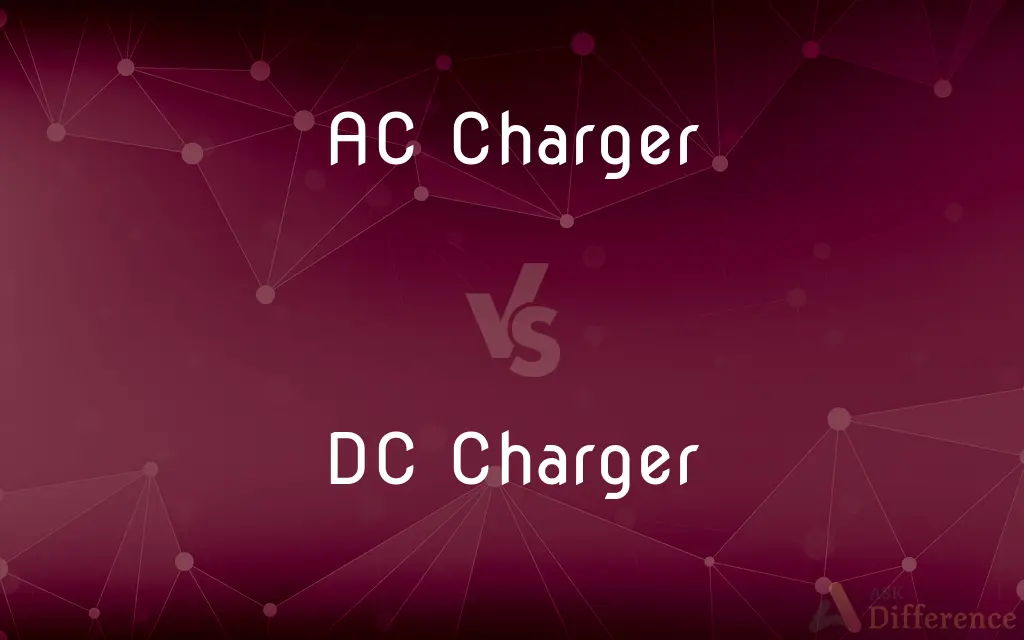AC Charger vs. DC Charger — What's the Difference?
By Tayyaba Rehman & Fiza Rafique — Published on March 8, 2024
AC chargers convert AC power from the grid to DC power for battery storage, suitable for home use, while DC chargers bypass internal conversion, providing fast charging directly to the battery, ideal for commercial settings.

Difference Between AC Charger and DC Charger
Table of Contents
ADVERTISEMENT
Key Differences
AC (Alternating Current) chargers are commonly used for charging electric vehicles (EVs) at home. These chargers take AC electricity from the power grid and convert it to DC (Direct Current) power, which is what batteries store. This conversion happens inside the vehicle, which limits the charging speed due to the onboard converter's capacity.
DC chargers, on the other hand, are equipped with external converters that convert AC power to DC before it reaches the vehicle. This allows for much higher charging speeds because it bypasses the vehicle's onboard conversion limitations. DC chargers are typically found in commercial or public charging stations and are ideal for quick charging during travel.
The main advantage of AC charging is its convenience for overnight home use, as it typically requires only a standard electrical outlet or a dedicated home charging unit. DC charging’s advantage lies in its rapid charging capability, making it possible to significantly charge an EV in under an hour, compared to the several hours required by AC chargers.
However, the faster charging speeds of DC chargers come with higher installation and operational costs, making them less common for private use. AC chargers, being more affordable and easier to install, are more widespread for personal charging stations.
Choosing between AC and DC charging ultimately depends on the specific needs of the EV owner, including their vehicle's compatibility, charging speed requirements, and access to public charging infrastructure.
ADVERTISEMENT
Comparison Chart
Power Conversion
Converts AC to DC inside the vehicle
Converts AC to DC externally
Charging Speed
Slower, suitable for overnight charging
Faster, suitable for quick charging
Installation Location
Primarily home and some public locations
Commercial and public locations
Cost
Lower installation and operational costs
Higher installation and operational costs
Vehicle Compatibility
Compatible with most EVs
Compatibility varies, generally higher
Compare with Definitions
AC Charger
Widely compatible with most electric vehicles.
A Tesla Model 3 charging at a public AC charging station.
DC Charger
Ideal for commercial and public settings.
A network of DC fast chargers at shopping centers for EV drivers.
AC Charger
They convert AC to DC inside the vehicle.
An EV uses its onboard converter to charge from a household AC outlet.
DC Charger
Higher installation and operational costs.
Setting up a DC charging station with high-power output capabilities.
AC Charger
AC chargers provide convenient overnight charging.
Charging an electric car at home using a Level 2 AC charger.
DC Charger
Offers quick charging for longer trips.
Adding 200 miles of range to an EV in about 30 minutes at a DC fast charger.
AC Charger
Slower charging suitable for daily use.
Plugging into an AC charger overnight to prepare for the next day’s commute.
DC Charger
DC chargers enable rapid charging on the go.
Using a DC fast charger at a highway rest stop to quickly top up an EV.
AC Charger
AC chargers are cost-effective for home installation.
Installing a basic AC charging station at a residential garage.
DC Charger
They bypass the vehicle's onboard conversion.
A Nissan Leaf directly accepting DC power for fast battery charging.
Common Curiosities
What are the costs associated with installing a DC charger?
DC chargers have higher installation and operational costs due to the need for high-power infrastructure and external conversion equipment.
Where are AC chargers typically installed?
AC chargers are commonly installed at homes and some public locations due to their lower cost and slower charging speed.
Can any electric vehicle use a DC charger?
While many newer and higher-end EVs support DC fast charging, compatibility varies, and not all EVs can use all types of DC chargers.
What is the difference between AC and DC charging?
AC charging involves converting AC to DC inside the vehicle, while DC charging involves an external conversion, allowing for faster charging speeds.
Is it possible to install a DC charger at home?
While technically possible, the high costs and power requirements make DC chargers impractical for most home installations.
Can the use of DC chargers damage an electric vehicle's battery?
While DC fast charging is safe, frequent use can potentially lead to quicker battery degradation compared to slower AC charging.
How do I know if my vehicle is compatible with DC fast charging?
Vehicle specifications or the owner's manual will indicate whether an EV is compatible with DC fast charging and the specific types supported.
Why are DC chargers faster than AC chargers?
DC chargers provide power directly in DC form, bypassing the vehicle's internal conversion limits and enabling higher charging speeds.
Do public charging stations offer both AC and DC charging?
Yes, many public charging stations offer both types of charging to accommodate different vehicles and charging needs.
What makes DC charging suitable for long trips?
The ability to quickly charge an EV’s battery makes DC charging ideal for long trips, minimizing the time spent at charging stations.
How long does it take to charge an EV with an AC charger?
Charging times can vary widely but typically range from a few hours to overnight, depending on the charger's level and the vehicle's capacity.
Which type of charger is more common for everyday use?
AC chargers are more common for everyday use, especially for home charging, due to their convenience and lower costs.
Why might someone choose AC charging over DC for their EV?
The main reasons include the convenience of home charging, lower costs, and the suitability of slower charging for daily needs.
Are there different levels of AC charging?
Yes, there are different levels, with Level 1 being the slowest (using a standard household outlet) and Level 2 providing faster charging speeds.
What advancements are being made in EV charging technology?
Ongoing advancements aim to increase charging speeds, improve battery health during fast charging, and expand the infrastructure for both AC and DC charging.
Share Your Discovery

Previous Comparison
Lactide vs. Lactone
Next Comparison
Graphics Card vs. Video CardAuthor Spotlight
Written by
Tayyaba RehmanTayyaba Rehman is a distinguished writer, currently serving as a primary contributor to askdifference.com. As a researcher in semantics and etymology, Tayyaba's passion for the complexity of languages and their distinctions has found a perfect home on the platform. Tayyaba delves into the intricacies of language, distinguishing between commonly confused words and phrases, thereby providing clarity for readers worldwide.
Co-written by
Fiza RafiqueFiza Rafique is a skilled content writer at AskDifference.com, where she meticulously refines and enhances written pieces. Drawing from her vast editorial expertise, Fiza ensures clarity, accuracy, and precision in every article. Passionate about language, she continually seeks to elevate the quality of content for readers worldwide.
















































